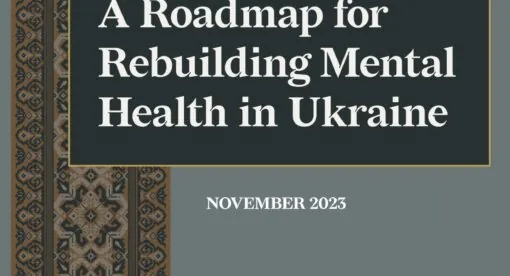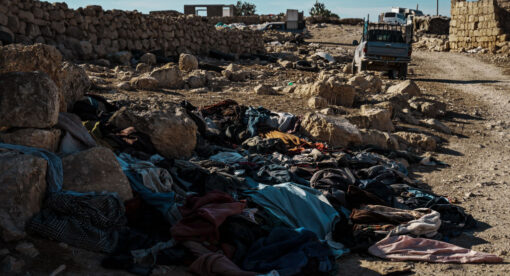The Weekly Forecast Monitor is a forward-looking assessment of geopolitical dynamics that are shaping the international system. To get more in-depth analysis of these issues and learn more about analytical products from New Lines Institute — including simulations, training sessions, and forecast reports — contact us at [email protected] and visit https://newlinesinstitute.org/analytical-products/. Download PDF version.
Global Hotspot Tracker
The Global Hotspot Tracker examines the outlook for key geopolitical hotspots around the world. (Go to the Global Connectivity Tracker)
Middle East/North Africa Regional Tensions
Summary – Diplomatic efforts to secure a cease-fire between Israel and Hamas continued amid looming pressure to reach a deal before an Israeli ground offensive in Rafah. U.S. Secretary of State Antony Blinken said the “gaps are narrowing” in cease-fire talks and that the Israeli negotiation team has been given authority to make a deal. The U.S. offered alternatives to such an offensive, including Israel focusing its efforts on preventing weapons smuggling through the Philadelphi Corridor. In Yemen, al-Houthi rebels continued attacks on commercial shipping and launched a missile at the Eilat region in Israel.
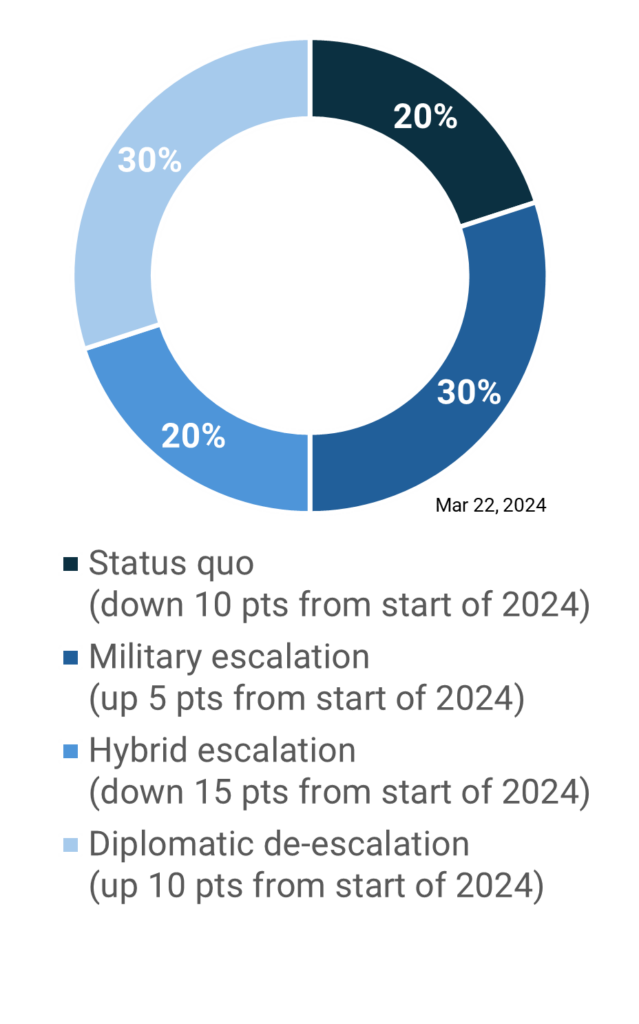
Military escalation scenario
- Israeli Prime Minister Benjamin Netanyahu continued to push for a Rafah offensive. On Wednesday, Netanyahu said evacuation plans for Palestinians in Rafah would be approved soon.
Risk level – medium - Israel launched missiles at multiple sites in southern Syria, injuring one Syrian soldier.
Risk level – low
Hybrid escalation scenario
- Al-Houthi rebels claimed to have launched a missile at the Eilat region in Israel. Israel confirmed a missile struck open space. The Eliat port is important to Israeli trade.
Risk level – medium
Diplomatic de-escalation
- David Barnea, head of Mossad, traveled to Qatar to resume negotiations after Israel rejected a Hamas proposal. A Qatari official expressed cautious optimism, and Blinken said the “gaps are narrowing” between the two sides.
Opportunity level – medium - The U.S. proposed several alternatives to a major Israeli ground offensive in Rafah, including preventing weapon smuggling through the Philadelphi Corridor. These alternative proposals come shortly after U.S. President Joe Biden told Netanyahu during a phone call that the U.S. would not support the proposed Rafah offensive.
Opportunity level – low
Russia/Ukraine Conflict
Summary – The Russia-Ukraine conflict is trending toward military and hybrid escalation scenarios as Ukraine and Russia continued attacks against each other’s energy and military sites and Russia retaliated with air strikes in Kyiv and announced the evacuation of children from border regions. The EU is advancing in discussions on using frozen Russian assets to fund Ukraine. Vladimir Putin won a landslide victory in Russia’s presidential election, which Western countries condemned as neither free nor fair.
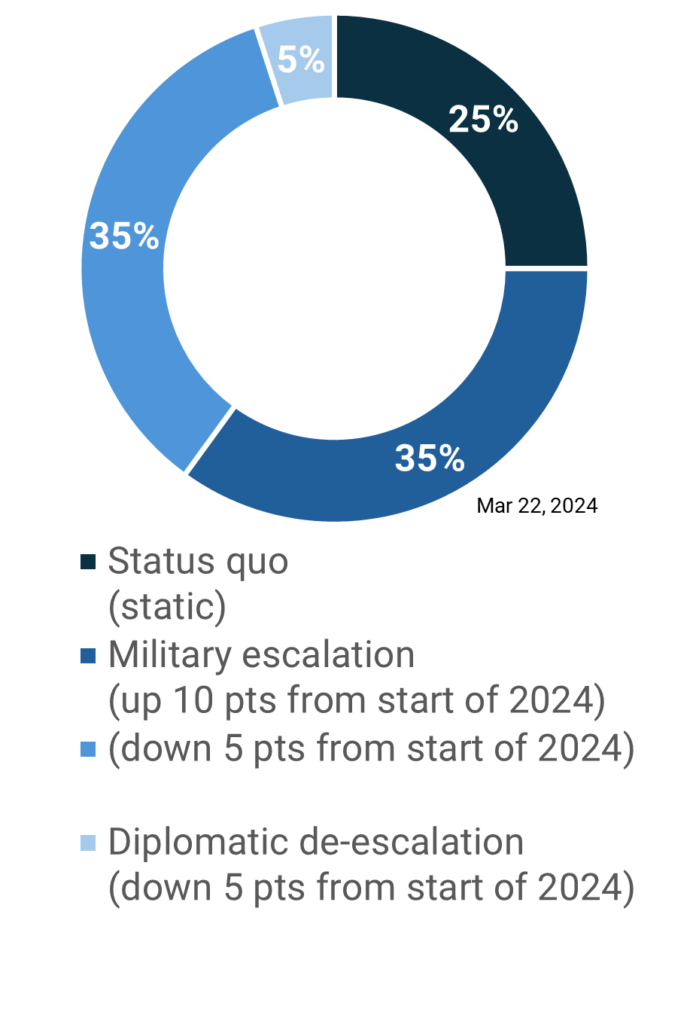
Military escalation scenarios
- Ukraine conducted missile strikes and shelled the Russian city of Belgorod near the Ukrainian border, prompting Russia to evacuate around 9,000 children from the region.
Risk level – low - Russia launched missile attacks against Kyiv in retaliation for Ukraine’s attacks in Russian territory.
Risk level – low - Russia warned that SpaceX plans to build a network of spy satellites with a U.S. intelligence agency could make them legitimate targets for military strikes.
Risk level – medium - A drone struck a military base in the breakaway territory of Transnistria, according to Moldova’s Bureau of Reintegration.
Risk level – medium
Hybrid escalation scenario
- Ukraine continued drone attacks against oil refineries in Russia, including in the Krasnodar and Samara regions. The U.S. has urged Ukraine to stop attacks against Russian energy infrastructure.
Risk level – medium - Russia attacked energy facilities in Ukraine, including the Dnipro Hydroelectric Station.
Risk level – medium - EU leaders agreed in a summit on March 21 to move ahead with a plan to use frozen Russian assets to fund Ukraine. European Commission President Ursula von der Leyen said the first 1 billion euro disbursement could take place on July 1, as Western banks warned this move could lead to costly litigation.
Risk level – medium - The EU is preparing tariffs on grain imports from Russia and Belarus that would increase prices by at least 50%, in the first such restriction since the full-scale war in Ukraine began.
- Risk level – low
Diplomatic de-escalation
- Qatar mediated an agreement to hand over six Ukrainian children from Russia to Ukraine.
- Opportunity level – low
- Russia said any agreement related to nuclear arms control with the U.S. would have to consider broader negotiations related to the war in Ukraine.
- Risk level – low
China/Taiwan/U.S. Tensions
Summary – U.S., Taiwan, and China tensions continued to trend toward military and hybrid escalation scenarios. The U.S. awarded $8.5 billion in grants to Intel for efforts to revitalize the U.S. chipmaking industry. The Department of Defense requested an 8% increase in the Pacific Deterrence Initiative budget for 2025. Blinken made said the U.S. would stand by its mutual defense treaty with the Philippines if the latter was attacked. The U.S. also is considering sanctioning Chinese semiconductor firms.
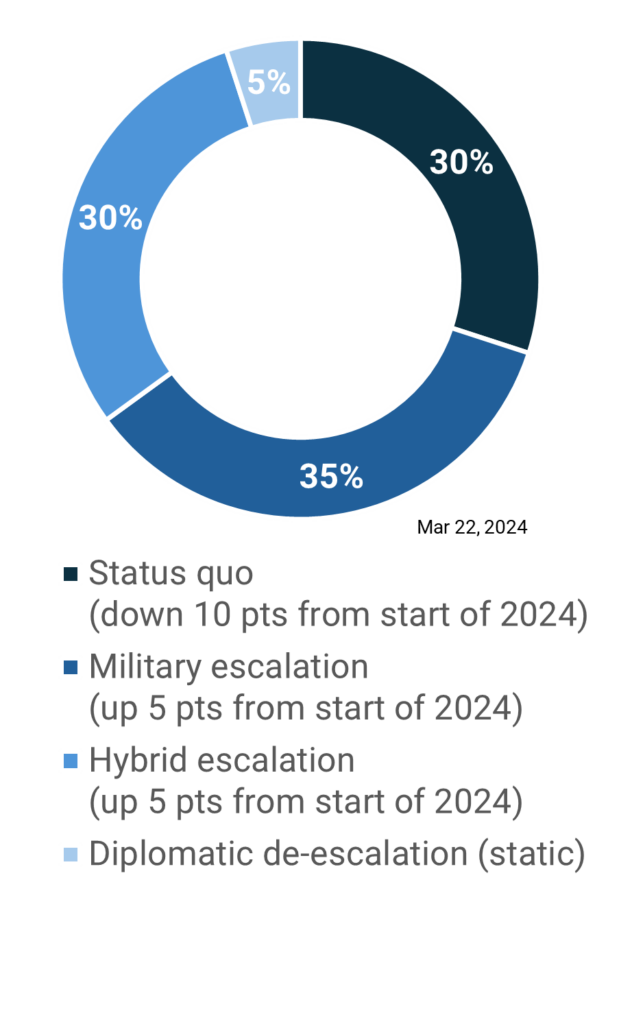
Military escalation scenario
- The Kinmen Defense Command, under the direction of the Taiwanese army, will participate in live-fire combat readiness drills.
Risk level – medium - China increased patrols around the Taiwanese island Kinmen to normalize its patrols in Taiwanese waters. Chinese coast guard ships continued to return after being chased from Taiwanese waters.
Risk level – low/medium - While in Manila, Blinken vowed U.S. support for the Philippines, noting the mutual defense treaty.
Risk level – low
Hybrid escalation scenario
- The U.S. has awarded Intel up to $8.5 billion in CHIPS Act funding for the revitalization of the U.S. chipmaking sector. The money will be used to fund the construction and expansion of chip manufacturing plants in Arizona, New Mexico, Ohio, and Oregon.
Risk level – low - The Biden administration is considering sanctioning Chinese semiconductor firms that have ties to Huawei Technologies.
Risk level – medium - The U.S. House of Representatives unanimously passed a bill that would restrict the selling of sensitive information about Americans to adversary countries, including China.
Risk level – low - China criticized the U.S. and SpaceX after it was reported that the U.S. government contracted SpaceX to launch reconnaissance satellites.
- Risk level – low
Diplomatic de-escalation
- No indicators.
Global Connectivity Tracker
The Global Connectivity Tracker examines the impact of geopolitical dynamics on global energy security and the climate transition. (Go to the Global Hotspot Tracker)
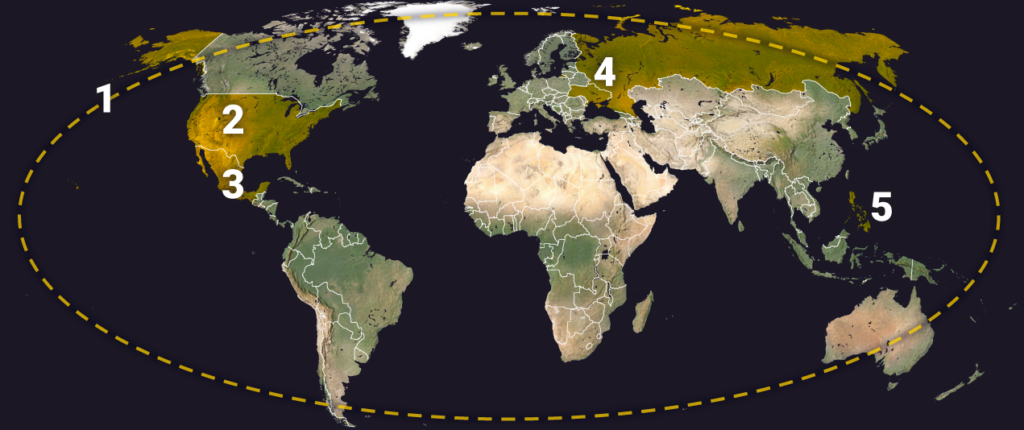
Energy/Climate
- Global
What happened: The shipping industry is consuming an additional 100,000 barrels per day of fuel as a result of longer routes being used to avoid the Red Sea due to conflicts in the Middle East.
Significance/Outlook: Due to the current tensions in the Red Sea, ships are traveling 3% farther than they were prior to the start of al-Houthi rebel attacks on commercial shipping. In addition to using more fuel, ships traveling around the Cape of Good Hope are increasing speed to make up for lost time, leading to an increase in carbon emissions. In 2022, international shipping contributed to 2% of global carbon emissions. Current shipping disruptions pose a challenge to the shipping industry achieving its goal of net zero GHG emissions by 2050.
Risk level – medium - United States
What happened: Lithium Americas Corp. has secured a conditional $2.26 billion loan from the U.S. Department of Energy to establish lithium processing facilities in Nevada.
Significance/Outlook: As lithium-ion batteries are the future of transportation and energy storage, increasing the supply of lithium is of the utmost importance for a clean energy transition, and local production of lithium is important to the economy and national security of the United States. Currently, the U.S. imports most of its critical energy transition minerals (copper, lithium, nickel, cobalt). China supplies the majority of the U.S.’s lithium-ion batteries. The largest lithium reserves in North America, in Nevada, will be used to build a lithium processing facility to boost U.S. lithium production and reduce dependency on China.
Opportunity level – medium
- Mexico
What happened: Pemex, Mexico’s public energy corporation, plans to reduce emissions by 30% over the next six years and become net-zero by 2050.
Significance/Outlook: The state-owned energy corporation Pemex was responsible for the leakage of significant quantities of methane from an oil platform located in the Gulf of Mexico in 2023. The leaks continued even after a United Nations agency brought the issues to the attention of the Mexican government. The Pemex plan is in line with the COP28 global methane reduction pledge. Countries that account for 45% percent of the world’s methane emissions have committed to a 30% reduction in emissions by 2030.
Opportunity level – low - Ukraine/Russia
What happened: Drone attacks by Ukraine against Russian oil refineries have taken out 600,000-900,000 barrels of daily refining capacity, according to various estimates. The U.S. has reportedly urged Ukraine to halt attacks against Russian energy infrastructure due to its impact on rising gasoline prices.
Significance/Outlook: Ukraine’s persistent and growing attacks against Russian energy infrastructure have forced Russia to cut production and exports of crude oil and refined products. Such attacks are cutting into Russia’s energy revenues, which are used to fund Russian military operations in Ukraine. These attacks have added a risk premium to Russian refined products, while Moscow announced in an OPEC+ meeting that it would cut oil exports by 120,000 bpd in April. They have also contributed to rising oil and gasoline prices.
Risk level – low - Philippines
What happened: The Philippines plans to start energy exploration efforts in the South China Sea with potential help from the U.S. and other allies.
Significance/Outlook: Despite its relatively low energy consumption compared to its neighbors, the Philippines is a net importer of energy. Energy exploration could provide a significant energy supply for the country and help it meet its energy needs. These latest efforts in energy exploration also come as the Philippines attempts to transition away from fossil fuels and coal to liquefied natural gas (LNG). In recent years, other countries in the region, including Indonesia, have approved energy exploration projects.
The Philippines has tried for years start energy exploration efforts and even sought partnership with China. However, when the most recent talks with China stalled, Manila began conversations with others, including the U.S., opening an opportunity for deeper economic relations between the two countries. While the South China Sea is rich in oil and gas, tensions between the U.S. and China – and China’s claim to much of the South China Sea – may hinder or delay efforts.
Opportunity level – low/medium
Key Stats of the Week
- China was responsible for most lithium-ion battery imports into the United States in 2022, with a total trade value of $9.9 billion.
- The United States also imported lithium-ion batteries worth $1.3 billion from South Korea and $1.0 billion from Japan in 2022.
- The total value of lithium-ion batteries imported into the U.S. has nearly tripled from $4.8 billion in 2020 to $13.9 billion in 2022.




